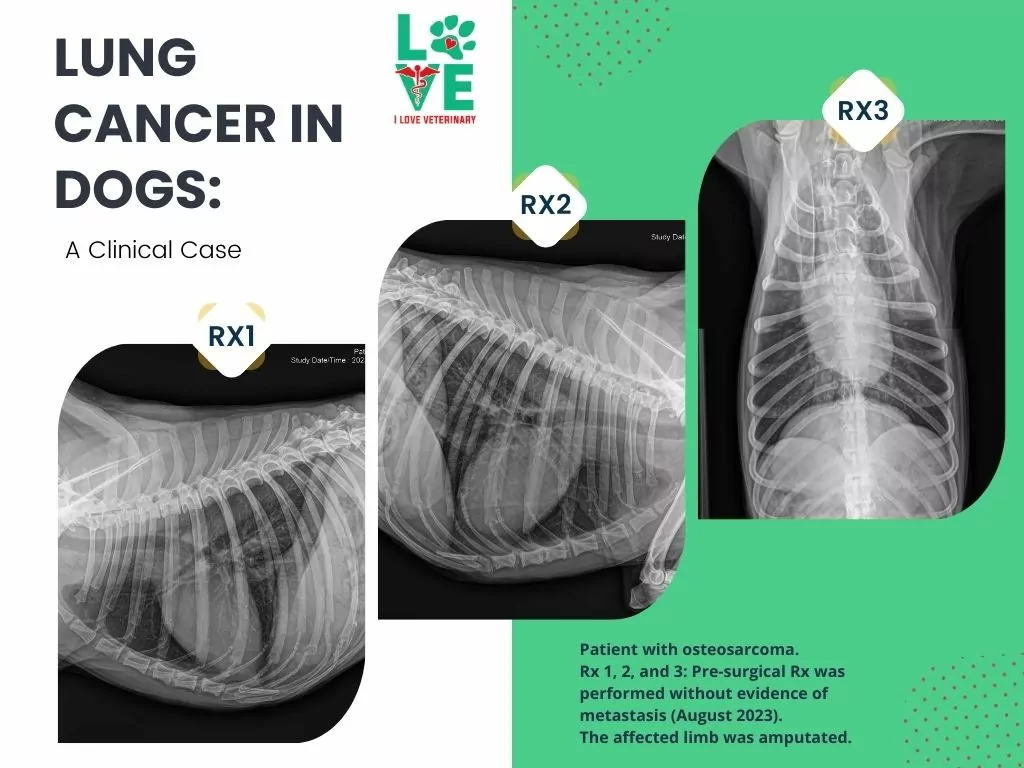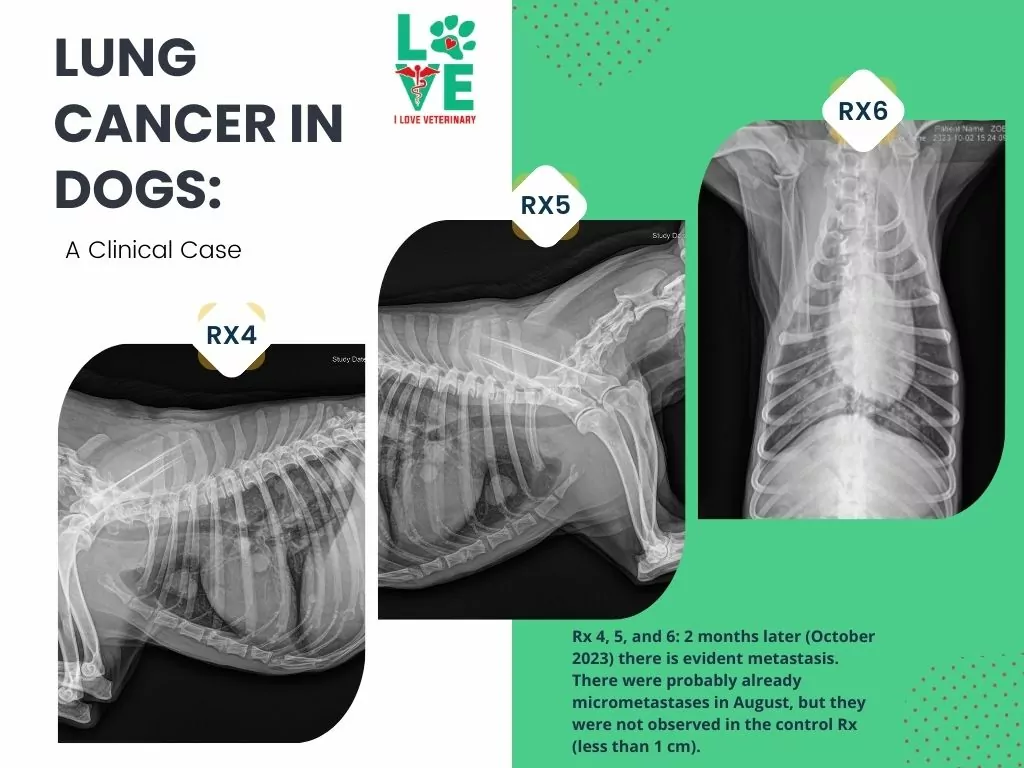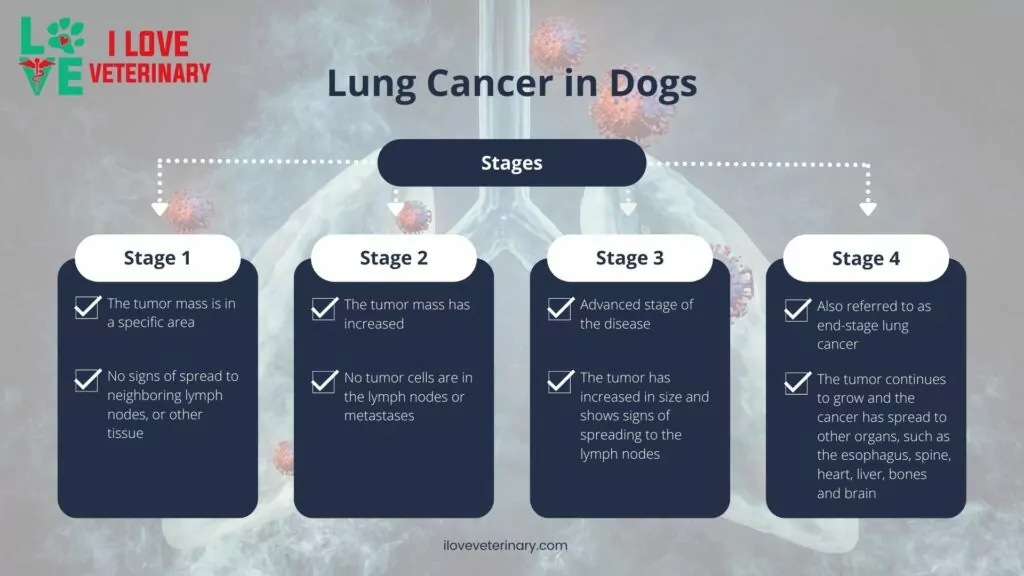Dog lung cancer might be rare, but cases are rising. Today, our veterinary experts share their expertise on the causes, diagnosis and treatment options available to provide the best care possible.
Probability and Pre-Disposition
Lung cancer in dogs is often asymptomatic until advanced stages, limiting treatment options. Some breeds, like Boxers, Pugs, and Bulldogs, are predisposed due to inefficient nasal filtration.
Bernese Mountain Dogs and Flat-Coated Retrievers have a higher incidence of primary lung tumors. Diagnosis typically occurs in older dogs, around nine to 11 years old, with no sex predilection.
Causes of Canine Lung Cancer
How do dogs get lung cancer? To date, the specific causes that lead to the appearance of primary lung tumors in dogs are not known.
Predisposing causes of lung cancer in dogs are:
- Exposure to cigarette smoke in smoking owners,
- Environmental pollution, and
- Inhalation of toxic chemicals in the environment.
All these situations can increase the risk of developing this pathology.
Lung Cancer Types in Dogs
Primary lung tumors in dogs are rare. Yet, when they do occur, they are usually malignant.
The most common primary lung neoplasms arise from glandular structures, known as “adenocarcinomas” or “bronchogenic carcinomas.” Adenocarcinomas are the most frequent type and constitute 70-85% of all primary lung tumors [1].
Also, primary lung tumors may arise from part of the lung tissue that provides support (termed with the ending “sarcoma“), such as:
- Fibrosarcoma: from fibrous tissue.
- Chondrosarcoma: of the cartilage.
- Hemangiosarcoma: of the blood vessels.
“Malignant pulmonary lymphoma” and “malignant pulmonary histiocytosis” are neoplasms primarily found in Bernese Mountain Dogs and Flat Coated Retrievers, showcasing distinctive lung alterations.
While primary lung tumors are rare, metastatic tumors are more common, stemming from other primary tumors like breast or bone tumors. The incidence of pulmonary metastasis varies among tumor types; in one study of 346 dogs with diverse tumors, 47 had detectable lung metastases on X-rays [2].
Diagnosis
The main goal of making an accurate diagnosis is to determine the extent and stage of lung cancer. Treatment will vary according to these two factors.
Below describes the diagnostic pathway for detecting lung tumors in dogs.
Clinical Examination
The veterinarian will check the dog’s general condition, and the examination should include determining the respiratory rhythm, the color of the mucous membranes, and auscultation of the thorax.
If the veterinarian suspects lung cancer, he/she will request the following tests.
Chest X-Rays
A distinct mass in lung tissue indicates primary lung disease, often found in the caudal lobes. Lung metastases manifest as round nodular masses or scattered infiltrates. Various tumors, like carcinomas and osteosarcomas, produce different types of nodules.
Assessing metastases presence guides treatment decisions. Lung radiographs have a 75% sensitivity for detecting tumors, influenced by film quality, projections, nodule size, and interpreter experience.
Lesions under 0.39 inches may not show on radiographs, necessitating CT scans when in doubt [3].


CT Scan
The CT scan is a very sensitive and precise study with which we can determine the exact location and size of the tumor, find small nodules radiographs do not detect, and assess the extent of the cancer.
All this data is instrumental when planning the most appropriate treatment for the patient.
Biopsy/Ultrasound Guided Aspirate
A biopsy means extracting a sample of cells or tissue from a living being for diagnostic purposes. The goal is to identify the type of cancer the patient has.
Types of lung biopsy include:
- Ultrasound-guided fine needle aspiration (FNA).
- Core needle aspiration.
- Surgical biopsy.
Bronchoscopy
This method involves inserting a flexible instrument (bronchoscope), under sedation, through the trachea to look into the lungs and take samples. It is not a diagnostic method unless the tumor masses extend into the bronchus.
Bronchoalveolar Lavage
Along with bronchoscopy, a bronchoalveolar lavage is helpful for diagnosis. During this test, the doctor introduces sterile fluid into the airways and then aspirates it to study its cellular contents.
Routine Bloodwork
A complete bloodwork examination shows the dog’s general condition. If the dog shows organic damage, the veterinarian should stabilize it before considering a possible treatment.
Abdominal Ultrasound
An abdominal ultrasound will show the state of the abdominal organs as well as the presence of a primary tumor, if any.
Not all lung masses are tumorous. The so-called pulmonary granulomas are non-tumorous and can originate from aspiration of a foreign body, parasites, or fungi. Diagnosing a lung mass and applying the specific treatment is very important.
Stages of Dog Lung Cancer
The next step after confirming the disease is to determine its stage. Lung cancer staging protocols for dogs include three parameters:
- The size of the primary tumor,
- Nearby involved lymph nodes.
- Presence/absence of metastases
Staging the tumor is important to determine the specific treatment for the patient and estimate the dog’s prognosis.
These stages include:

Signs and Symptoms
When the tumor increases in size, it begins to compress the internal structures of the lungs. It’s from this moment on that we will notice signs and symptoms of lung cancer in dogs, such as:
| Cough | Chronic and long-lasting |
| Shortness of Breath | Accompanied by rapid and open-mouthed breathing, and noises even during rest periods. Some dogs may pass out |
| Lethargy | Less interested in usual activities and sleeping a lot |
| Appetite Loss | Leading to weight loss |
| Regurgitation | Large tumors located close to the esophagus and food passage is prevented into the stomach |
Although symptoms like coughing, difficulty breathing, and lethargy can indicate lung cancer in dogs, they’re not exclusive to it and can signal other issues.
Consulting a vet and conducting thoracic diagnostic studies is crucial if these symptoms persist or if empirical treatment fails. Some dogs may present with leg pain and exercise intolerance, revealing hypertrophic pulmonary osteopathy on limb X-rays.
This condition often stems from a primary lung tumor, emphasizing the importance of chest radiographs and limb assessments.
Available Treatment Options
The treatment of lung cancer in dogs often depends on the stage of the disease. The following is a complete description of the different treatment approaches depending on the progression of the tumor.
Stage 1: Early Stage
Surgery
If the tumor is small and accessible, the treatment of choice is to remove the cancer along with the affected lung lobe.
Radiation Therapy
It offers the possibility of controlling and, in some cases, eradicating the cancer, thus improving the animal’s quality of life.
Stage 2: Intermediate Stage
Surgery and Chemotherapy
Surgery may still be possible, but it is often combined with chemotherapy to fight the spread of cancer and reduce the chance of recurrence.
Chemotherapy involves the administration of drugs that inhibit the growth of cancer cells.
Targeted Therapy
Newer therapeutic approaches target cancer cells without damaging healthy tissue. If surgery is not possible or unsuccessful, this may be an option. These therapies tend to have more specific and less toxic side effects.
Stage 3: Advanced Stage
Chemotherapy
This is usually the main treatment to shrink the tumor and slow its spread to other organs.
Immunotherapy
This stimulates the immune system to recognize and attack cancer cells. It can be particularly effective in certain cancer types with the advantage of causing fewer side effects.
Stage 4: Metastatic Stage
At this stage, neither surgery nor the above-mentioned medical treatments work. The focus often is on alleviating symptoms and improving the dog’s quality of life.
Prognosis and Outcome
The prognosis for dogs with lung cancer varies by type and stage. Survival averages one year for primary tumors without lymph node spread. Smaller tumors increase survival chances. Dogs with lymph node involvement have a six-month expectancy.
For dogs with metastatic lung cancer life expectancy is less than six months, depending on tumor aggressiveness. We don’t recommend surgical removal of the primary tumor with metastasis, as it accelerates metastatic growth, leading to imminent death.
Caring For A Dog With Lung Cancer
When lung cancer becomes untreatable, palliative care becomes essential. This includes pain management, nutritional support, and other therapies for comfort.
Steroidal and non-steroidal anti-inflammatory drugs can ease inflammation, while options like CBD oil and analgesics help manage pain. Bronchodilators prevent respiratory distress, and muscle relaxants or anxiolytics address anxiety. Most importantly, cherish every moment with your beloved pet.
Farmer & Chemist – RUFF DAYZ – 1200mg Medium – Large Dog Tincture

Farmer & Chemist – RUFF DAYZ – 600mg Small Pets Tincture

Parting Thoughts
It’s unclear what causes lung cancer in dogs, making it unpredictable. While some factors can’t be controlled, there are preventive steps you can take.
If you have a female dog, consider spaying her to reduce the risk of lung cancer due to mammary tumors. Act now to safeguard your furry friend’s health.
FAQ
Do Dogs With Lung Cancer Cough A Lot?
No, not all dogs with lung cancer cough.
Is Lung Cancer in Dogs Painful?
The end-stage lung cancer in dogs can be painful and very stressful due to difficulty breathing. However, the earlier stages are usually not painful.
How Common is Lung Cancer in Dogs?
The annual incidence rate of primary lung neoplasms in dogs is 10 cases per 100,000 animals [4].
How Long Can A Dog Live With Lung Cancer Without Treatment?
Without treatment, a dog with lung cancer lives between three to six months. However, some dogs may live longer, while others may die sooner.
Should I Put My Dog Through Cancer Treatment?
The decision to treat your dog for cancer is a personal and complex one. There is no right answer to this question. Your veterinarian can help you make the best decision for your dog and can provide support during this difficult time.
Can Dog Lung Cancer Be Prevented?
You can’t prevent lung cancer in dogs, but they can lead a healthy and balanced lifestyle! Be sure to provide a good-quality diet and daily exercise.
How Aggressive is Dog Lung Cancer?
In general, canine lung cancer is an aggressive disease. Carcinomas are the most aggressive tumors, followed by adenocarcinomas.
